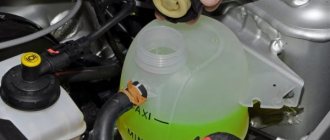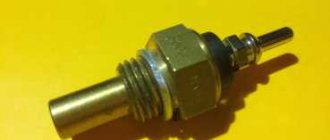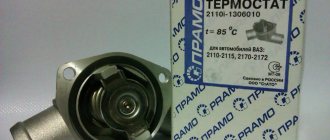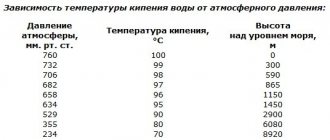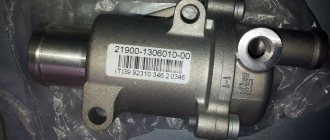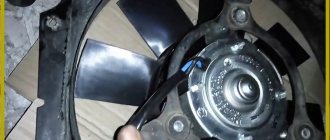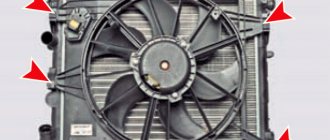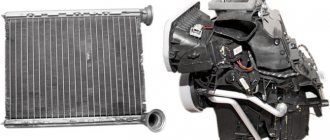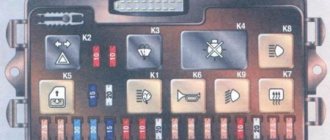The fan switching sensor is an element of the carburetor engine cooling system (2108, 21081, 21083) of VAZ 2108, 2109, 21099 cars. Purpose of the fan switching sensor
The fan switch on in the cooling system of a carburetor engine is designed to turn on or off depending on the coolant temperature of the fan on the radiator.
Location by car
The fan switch sensor is screwed into the threaded hole of the right (in the direction of the car) radiator cooling tank.
Fan sensor device
The sensor body is made of brass or bronze. This is an oblong cylindrical cylinder with a nut at the top, a thread in the middle, and a flat surface at the bottom. The connection between the sensor and the radiator is sealed with an aluminum or copper O-ring. The sensor has two outputs: one current is supplied (minus), the other goes to the fan switch relay (113.3747) in the mounting block (also minus). Inside the housing, the leads have two contacts. There is also a bimetallic plate located inside the case (attached to the bottom); as it heats up, it changes its curvature and closes the contacts.
Operating principle of the fan switch sensor
On VAZ 2108, 2109, 21099 cars until 1998. with mounting fuse block 17.3722 (finger type fuses).
The fan switch sensor is installed in the gap in the negative wire leading to the fan switch relay in the mounting block. When the temperature in the radiator of the cooling system rises to 99±3º C, the contacts inside the fan switch sensor are closed by a bimetallic plate, and an electric current (minus) flows through it to a relay in the mounting block. From the relay, the current (already a plus) goes to the electric motor of the fan on the radiator and turns it on.
On VAZ 2108, 2109, 21099 cars after 1998. with mounting blocks 2114, the fan switch relay is removed from the electrical circuit. The fan switch sensor is also installed in the gap of the negative wire, but this time goes directly to the fan. The contact closure temperature is similar.
If the temperature in the radiator drops below 93±3º C, the bimetallic plate opens the contacts and the fan electric motor is de-energized.
Malfunction of the fan switch sensor
The fan switch sensor rarely fails, since there is practically nothing to break there. The reasons for its failure may be poor workmanship or mechanical deformation. If you have problems turning on the fan on the radiator, you should first check its electrical connections. Having removed both wires from the sensor, we connect them together. Turn on the ignition. If the fan starts working, the on/off sensor is faulty. If not, the fault should be sought in other elements of the circuit.
Applicability of the fan switch sensor
The cooling system of the carburetor engine of VAZ 2108, 2109, 21099 cars uses the TM 108 sensor with markings on the body “99-94”. It works both through a relay in the mounting block in cars before 1998, and without a relay in cars of later years. Analogues of this sensor from different manufacturers are also available for sale.
Notes and additions
— On the injection engine of VAZ 2108, 2109, 21099 cars, the cooling system fan is turned on at the command of the control unit (ECU), which analyzes the readings of the coolant temperature sensor (DTOS).
— There is another temperature sensor in the cooling system of carburetor and injection engines of VAZ 2108, 2109, 21099 cars. This is the temperature indicator sensor in the instrument panel (TM 106). It only works on the temperature indicator.
More articles on the engine cooling system of VAZ 2108, 2109, 21099 cars
The essence of the post is already visible in the title. So the question is - why does the fan come on late?
A friend advised me to replace the temperature sensor, the one located near the thermostat.
see also
Comments 60
It always shows like this for me. I set the BC to 95 degrees and everything is fine
The expansion tank cap solved everything))
in the brain it is written to turn on the fan somewhere around 100-103 (personally, the electronic instrument shows me the 103 limit and it turns off at 98 degrees. As an option, re-flash the brains or buy an on-board vehicle with a “safari” function, something like that_ in general, the gist there is this , it is possible to change the temperature at which the fan turns on through it... the sensors are all the same, there is no difference _ it will turn on at the same temperature)))
Thanks for the advice, that's what I'll do)
This is a normal temperature, on all Eng 09 the ventilator turns on like this, don’t worry, it was 2 09 and on both of them it’s like that
They are simply afraid that the cylinder head will lead)))
Don’t suffer from bullshit, don’t interfere with the car’s work, everything is fine with your temperature)
I also want to think so, but the rising coolant level in the expansion tank does not give me peace of mind)))
I don’t know, I’ve been driving like this for a long time and in more than one car, a friend’s 9 does the same thing) and the flight is normal, it’s warm in winter)
Coolant temperature sensor for VAZ 2109 and 21099 cars
To begin with, it is advisable to know where it is located. On models 2108, 21099 and VAZ 2109, the coolant temperature sensor is installed between the cylinder head and the thermostat, in the exhaust pipe.
Device and principle of operation
The engine temperature controller itself is a thermistor-resistor device characterized by a negative temperature coefficient. The resistance parameter itself can be measured only when the temperature decreases or increases.
When the power unit heats up as a result of operation, the resistance indicator decreases; if the engine cools down, this parameter increases. For example, at the operating temperature of the engine on a VAZ 2109, the resistance is equal to 180 Ohms, and if it is 40 degrees cold outside, then the resistance will be equal to 100,700 Ohms. On one side of the DTOZH VAZ 2109 injector there are two contacts, and on the other there is a sensitive component, which is located directly in the flow of consumables.
As for the principle of operation, when the driver turns on the ignition, the control unit transmits voltage to the regulator via a resistor. Since the DTOZH itself is a thermistor, the voltage supplied from the control unit changes immediately taking into account the temperature of the consumable. When the parameter decreases, the unit analyzes the temperature and, in accordance with these data, determines the required volume of gasoline for injection. As the power unit warms up, the volume of gasoline that is transferred to the cylinders will decrease.
In addition to starting, according to the readings of the regulator, the ECU adjusts the operation of the power unit at idle speed. As a result, he independently makes decisions on enriching the combustible mixture at high and medium loads on the internal combustion engine. This indicator can be changed depending on the ignition timing.
There are two temperature sensors on a carburetor car. One turns on the fan, the other is responsible for indicating the temperature on the dashboard.
Possible faults
There are several reasons why the regulator on the VAZ 21099 refuses to work.
So, why DTOZH does not work:
- An electrical contact is located inside the device structure. Over time, this contact may simply break or cracks may form on it. If a break occurs inside the structure, this may cause complete failure. That is, the DTOZH will simply burn out. If there are cracks on the contact, the DTOZH, in principle, can work, but as a result of the lack of normal contact, the regulator will transmit incorrect data about antifreeze.
- Poor device insulation. If the insulation is broken, short circuits may occur in the operation of the device. Accordingly, ultimately, these short circuits can lead to the DTOZH, again, burning out and having to be replaced.
- There was a broken wire near the regulator. As a result of the break, the regulator will not be able to activate the fan designed to cool the power unit. Accordingly, this will lead to the engine overheating and may even boil (the author of the video is a Mechanical Technician).
What to do if the cooling fan on a VAZ-2109 does not work
From the moment electric fans began to be used on VAZs with carburetors, car enthusiasts often began to experience their failure.
Previous mechanical models were considered almost eternal. In most cases, when a VAZ-2109 fan with a carburetor is said to not work, the unit completely stops performing its functions. In this case, the engine temperature exceeds 100 degrees, and the car may fail. To avoid major repairs of the power unit, it is necessary to stop driving after the temperature needle deviates into the red zone. Then you need to find the reason why the fan is not working. You should start checking with the liquid level in the cooling system (check the expansion tank), and then gradually eliminate faults in other parts of the system:
- fuse;
- temperature sensor;
- electric fan motor;
- impeller (it can be deformed, which leads to jamming).
While performing work, you will have to check the condition of the power circuit along the way. All conductors should be visually normal. It is best to eliminate the probable causes of failure one by one so that the system operates stably.
How to check a fuse
This is the simplest part of the test, suitable if the power plant is equipped with a carburetor. You need to find a mounting block in the engine compartment of the VAZ-2109. In it, in place of F-4, there is a fuse responsible for the operation of the cooling fan. Pull it out of its seat, and then use a multitester to take a test measurement (performance test).
If the fuse is working, look for another fault. Otherwise, you need to put a new one in its place marked 16 A and run it in. If the fan is working, you don't need to do anything else. Otherwise, examine other parts of the cooling system.
Checking and replacing the temperature sensor
On a VAZ-2109, the cause of untimely operation or complete failure of the fan is often the coolant temperature sensor. Therefore, it needs to be checked secondarily. The sensor is located at the bottom of the radiator, two wires come from it. Before unscrewing it, you need to accurately check the operation of the cooling system:
- Connect the ends of the wires leading to the sensor together. If after this the fan starts working and the sensor gets hot, then this controller needs to be changed. When testing on a hot radiator, you may find that the sensor body is also warm. In this case, check the thermostat.
- If the fan does not work even after shorting the wires, then the problem may lie in the relay or fuse. The relay should be checked if the sound of its operation is not heard. Depending on the type of car, it may be located in the mounting block (for models with carburetors) or in the passenger compartment under the driver’s storage compartment (for injection cars). The easiest way to check this device is to install a similar device in its place. If after replacing the relay the fan starts working, you don’t have to carry out further testing.
- Sometimes the device does not work, but the sound of the relay operating is present. In this case, check fuse F-8.
If you do not find any faults in other systems, then you need to replace the temperature sensor in the cooling system. This is done according to the instructions:
- Turn off the ignition, remove the terminal from the battery and drain the fluid from the expansion tank and the generator. To do this, you need to remove special plugs.
- Then disconnect the sensor from the terminal block.
- Using a spanner wrench, unscrew the sensor from its place without applying excessive force.
What to do if the speedometer on a VAZ-2109 does not work
Install a new sensor and reassemble. Some car enthusiasts prefer not to drain the antifreeze from the system, but simply act quickly. In this case, after the sensor leaves the seat, a certain amount of coolant will leave the system, so it will need to be topped up.
Checking and replacing the electric motor
If after replacing the sensor the fan still does not work, then it is necessary to check and replace its electric motor. But first you need to dismantle it:
- Remove the negative terminal from the battery.
- Disconnect the fan from the power circuit (one of the blocks is located on its casing).
- Unscrew the mounting screws from the device casing: left and bottom.
- Using a socket with an extension, remove the fasteners connecting the casing to the generator.
- Remove the two nuts on the left to remove the fan pressure spring. Take it off.
- Pull out the entire assembly, along with the housing. Along the way, you may need to disconnect its wires.
Now you need to get to the electric motor and install a new one in its place:
- The electric motor wire is secured to the housing with a clamp; disconnect it.
- Then unscrew the three nuts to remove the motor.
- Inspect the motor seat; all rubber pads on it should be intact and not deformed. If you notice damage, install new gaskets.
- After this, you need to install a new motor in place of the old one and reassemble the fan.
Some car enthusiasts believe that it is possible to repair the engine, but in most cases their attempts do not lead to success.
How to change the impeller or align it
If, after dismantling the fan, you notice that the impeller is damaged or uneven, you need to remove it:
- There is a lock washer in the center of the impeller; pry it up with a flathead screwdriver and remove it. If there is an additional fastening in the form of a nut, unscrew it.
- Remove the impeller and inspect it. If there is any deformation, it is best to install another impeller.
During this work, you can upgrade the fan by installing an impeller with 8 blades instead of the standard 4.
Checking and replacing DTOZH
There are several options for diagnosing the device - the first one:
- The negative probe from the voltmeter must be connected to the engine and turn on the ignition.
- Using a tester, it is necessary to determine what voltage parameter is generated during movement.
- If the DTOZH is working, then the voltage should be at least 12 volts when the battery is fully charged. If the obtained indicators are lower, it is necessary to replace or repair the device.
Second diagnostic method:
- You will need to set the multimeter to voltmeter mode - measurements are carried out in the range from 100 Ohms to 10 kOhms. Also prepare a thermometer that can measure temperatures greater than one hundred degrees. The regulator should be removed and placed in a container with antifreeze.
- You need to warm up the coolant. As a result of an increase in temperature indicators, you need to monitor the readings given by the thermometer.
- Using a multimeter, you should measure the resistance of the DTOZH at different temperature conditions. The obtained parameters should be compared with those indicated in the table above.
How to make the replacement yourself:
- First of all, all the coolant must be drained from the radiator. Then disconnect the negative terminal from the battery, simply unscrew the nut with a wrench and disconnect it.
- Next, you need to disconnect the block with wires that connects to the DTOZH.
- Use a wrench to completely unscrew the device. Next, the regulator is removed from its seat; as mentioned above, this is the cylinder head exhaust hose. There is a rubber seal on the device itself; it cannot be lost when dismantling the DTOZH, especially if you have a new sensor without a seal.
- Then install the new regulator in its seat, in the outlet hose. Using a wrench, tighten the adjuster all the way. After installation and tightening, the previously disconnected wiring harness should be connected to the DTOZH. The final step in this process is to pour the antifreeze back into the radiator and reinstall the disconnected negative battery terminal.
VAZ 2109 and 21099 cars are equipped with a variety of sensors and regulators designed to ensure proper operation of the power unit as a whole. One of such devices is the sensor for turning on the VAZ 2109 carburetor fan, as well as the DTOZH - antifreeze temperature controller. Find out more about the devices in this article.
Video “How to correctly change the fan activation sensor”
How to replace the internal combustion engine on a VAZ 21099 car in a garage, and what mistakes should not be made - learn from the video published by the Thoughts and Advice channel from Mustafa Murtazaev.
Do you have any questions? Specialists and readers of the AVTOKLEMA website will help you ask a question
Support the project - share the link, thank you!
Rate the benefit of this article:
Discuss the article:
2021
Description of DTOZH and DVV
Where is the fan located and turned on in 2109 with an engine injector or carburetor, what should I do if the device does not work? First, let's look at the basic questions regarding the purpose, device and principle of operation.
Purpose and functions
The main purpose of the DVV is to activate and deactivate the ventilation device on the engine radiator in order to cool the power unit. The device turns the fan on and off based on the temperature of the liquid in the cooling system. On injection machines, this is DTOZH; turning the fan on and off is controlled by the brain according to the readings of this sensor.
As for the TOZh controller in the VAZ 21093, this device is intended to display readings about the antifreeze temperature on the car’s dashboard in the cabin. With its help, the driver can find out about possible overheating of the power unit.
Location
As for the location, in models 2108, 2109 and 21099 the DTOZH is located between the engine cylinder head and the thermostat, in particular, on the intake hose. The DVV is installed in the threaded hole of the expansion tank with coolant. If you look in the direction of travel of the car, the refrigerant container is installed on the right.
Principle of operation
First, let's look at the operating principle of the antifreeze temperature controller. This device is a thermistor-resistor that operates with a negative coefficient. The amount of resistance in this case can be measured as a result of a decrease or increase in the temperature range. When the car engine heats up, the resistance on the device decreases, and when the power unit cools down, this value increases. For example, when the engine is fully warmed up, the resistance value on the device is 180 Ohms, and at low negative temperatures (-40 degrees) this figure will increase to 100,700 Ohms.
When the driver activates the ignition by turning the key in the lock, the control module (ECU) begins to supply voltage to the controller using a resistor. The DTOZH itself, as mentioned above, is a thermistor; accordingly, the incoming voltage will change in accordance with the temperature of the liquid. When this value decreases, the control module analyzes this, according to which the required volume of fuel for injection into the cylinders is determined. As the car engine warms up, the volume of fuel used for injection will drop.
Methods for checking DTOZH
How to check the TOZ index on your own? To do this, you can use one of several methods; diagnostics are performed using a multimeter.
- First, the negative probe of the tester should be connected to the cylinder head, and then activate the ignition by turning the key in the lock.
- Then, using a multimeter, you need to determine exactly what voltage appears at the output.
- If the controller is working, then the value of this parameter should be at least 12 volts, of course, if the battery is fully charged. If the diagnostics showed that the obtained values were lower, then you need to do repairs or change the regulator (the author of the video about diagnostics is the Mechanical Technician channel).
Another check option:
- To implement it, you will need to configure the tester in voltmeter operating mode. The measurement procedure should be carried out in the operating range from 100 Ohm to 10 kOhm. In addition, for diagnosis you will need a thermometer, and it is important that it can determine a temperature value of more than 100 degrees. The controller itself is removed from its seat and lowered into a reservoir with refrigerant, which you will heat. This point must be taken into account when choosing a container for coolant.
- Now you will need to warm up the refrigerant in the system. When the temperature value increases, you need to carefully monitor the values produced by the tester and the thermometer placed in the container.
- Using a tester, you will need to check the fluid resistance level at different temperatures. The readings obtained as a result of the diagnosis must be compared with the normalized ones, which are indicated in the table.
Photo gallery “Self-diagnosis”
The radiator cooling fan does not turn on - reasons, troubleshooting
Problems with the cooling fan usually occur in used cars with decent mileage. This breakdown manifests itself in different ways; the fan may not work stably, may turn on late or not turn on at all. Today we will talk about the last fault, that is, the situation when the cooling fan does not turn on at a certain moment. You will learn about why this happens, where to look for the reason, and also in what sequence. Let’s take the “nine” as an example, but the method and reasons will be almost the same for all VAZ models.
Finding a breakdown is not so much labor-intensive as it is comprehensive, since there can be quite a few reasons why the fan does not turn on, from a banal fuse blown to more complex problems associated with a malfunctioning thermostat or problems with the electrical wiring of the vehicle’s on-board network.
If the engine boils, but the fan still does not turn on, then the first thing that comes to mind for most motorists is problems with the fan wiring. However, very often the wiring has nothing to do with it, and the real reason lies precisely in the thermostat. The device designed to monitor the temperature of the coolant (coolant) may fail or simply jam, after which the coolant stops circulating through the radiator, as a result, the radiator sensor does not work, and the fan itself does not turn on. Read this article on how to check the thermostat.
Possible malfunctions and ways to eliminate them
For what reasons may the device stop functioning:
- Internal damage to the contact located inside the device. In practice, as a result of prolonged use, this contact may break, and intensive use of the DTOZH may lead to the appearance of cracks on it. If the reason lies in a break, then this is fraught with complete breakdown of the controller - the sensor will simply burn out. If the problem is cracks, then the device may work, but not correctly. Due to the lack of contact, the controller will transmit incorrect information about the liquid, that is, incorrect values will be displayed on the instrument panel.
- Another reason is damage to the device’s insulation. If the device insulation is broken, the controller may operate with short circuits. Short circuits in its operation can cause complete failure of the device.
- There is a break in the electrical circuit near the controller. Due to damaged wiring, the device will not be able to transmit antifreeze data to the dashboard. Accordingly, if the engine overheats, the driver may not even know about it.
What symptoms can you use to determine if this device is not working:
- The car engine became difficult to start when hot. That is, you can start it in the morning, but when the unit warms up, problems appear.
- Increased fuel consumption. You can only identify such a sign when you carefully monitor the car’s performance. The increased fuel consumption is due to overload of the power unit when it is warmed up.
- If the DTOZH breaks down and no longer functions, then the control panel will display incorrect data on the engine temperature. It usually takes no more than 10 minutes to fully warm up the internal combustion engine. If 10 minutes after starting you notice that the arrow on the indicator on the dashboard has not gone up, then most likely the DTOZH needs to be changed (video shot by Dmitry Yakovlev).
Replacing the fan switch sensor on a VAZ 2108, VAZ 2109, VAZ 21099
Note! Before purchasing a new sensor, pay special attention to its markings, which are indicated on the edges. This marking must correspond to the sensor that is installed on your car, because all sensors are designed for different car models, and thus each sensor has its own specific response temperature!
When do you need to change the fan switch sensor? • If it fails, namely if the sensor stops turning on the engine cooling fan when the engine heats up to a high temperature.
Instructions for replacing the TOZh sensor with your own hands
Replacing the DTOZH is carried out as follows:
- First you need to turn off the ignition and open the hood of your car.
- Next, you need to place a container under the drain hole of the engine radiator; all the coolant will collect in it. Open the plug and drain the antifreeze, then find the DTOZH and disconnect the connector from it.
- Using a wrench, you will need to dismantle the controller. The device is removed from its installation location. When removing you can see the rubberized seal, when you remove the regulator, do not lose it. If you notice that the rubber band is very worn, it will need to be replaced.
- After this, you will need to install the new controller in the installation location. Using a wrench, screw the device all the way, and then connect the connector with the wire that you disconnected when dismantling. Now all you have to do is pour the working fluid into the radiator device and turn on the ignition, start the engine and check the operation of the device.
Sensor
Don't rush to change the fan right away. Often the problem was a sensor, relay, fuses, or simply broken wiring. First of all, we will check the sensor and also tell you about the features of replacing it.
The fan switch sensor is located at the bottom of the radiator. A couple of wires come off it.
Searched device
Accurate check
In order not to rush to conclusions, experts first advise checking the sensor for functionality.
- If the fan does not want to turn on according to the standard circuit, try shorting the wires that go to the sensor. If the fan is running and the sensor is hot, the problem lies there. If the radiator is hot during testing, the sensor housing may be warm. This suggests that you should check the condition of the thermostat and the coolant level in the tank. You may need to change and top up accordingly.
- If, after closing the wires, the fan does not turn on, the sound of the relay being activated is not observed, check the condition of the relay and fuse. It is number 4 in the mounting block.
- By shorting the wires, the fan did not start, but the relay worked. Here you should check fuse number 8.
- If the fan starts randomly on a cold engine, it does not turn off for a long time, try disconnecting one wire from the sensor. If the fan stops, the sensor contacts are stuck. If the fan continues to turn, sticking has occurred on the contacts of the control relay.
Having discovered that the regulator has failed, there is nothing left to do but change the radiator fan activation sensor.
Replacing the sensor
Changing the sensor is quite simple:
- Turn off the ignition;
- Drain the coolant from the expansion tank;
- Disconnect a pair of wires from the sensor terminal block;
- Using a 30 mm wrench, unscrew the regulator from its seat. You shouldn’t apply a lot of force; you risk breaking the seat;
- Following the reverse sequence, install the new sensor.
Disabling the sensor
You can change the sensor without draining the coolant. To do this, you need to quickly unscrew the old regulator and screw in a new one in its place. A small part of the coolant will spill out, but you won’t have to drain it for a long time and then pour it back in.
